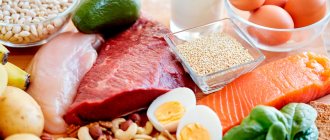Beautiful muscle definition is preceded by a gain of lean muscle mass through proper nutrition and intense training . If you want to take care of your body yourself, without resorting to the services of nutritionists and trainers, then you should highlight two main tasks for yourself:
- Clearly think through the program of sports activities, selecting the weight of the equipment and intensity of exercise in accordance with your physical fitness;
- Create a menu for the week.
Remember that if you are overweight, you will not be able to gain lean mass. First of all, we recommend losing weight, and for these purposes we have developed menu options such as Fit and Super Fit. They are low in calories, but high in nutrients, vitamins, and minerals. With such a diet, you will quickly get yourself in order and can begin to gain quality mass in the form of elastic, beautiful muscles.
What is dry mass gain?
What is lean mass gain? This is a special training and diet regimen that increases the volume of muscle tissue without the formation of fat. By the way, in most cases, the first stage of the “work” of an athlete working on muscle volume is to increase total weight. Naturally, this result is achieved not only due to the development of muscle tissue, but also due to the appearance of fat caused by excess calories in the body. Only after this the athlete begins to work on burning these same fats in order to get beautiful and sculpted muscles (yes, like Schwarzenegger’s).
The essence of gaining lean mass is to increase weight only through muscle growth, but without the formation of excess fat tissue.
Meal time
For athletes, an exercise program and regularity of exercise are important, but without a balanced diet this will only be part of success. To get a guaranteed result, you need, in addition to understanding what to eat, to consider when to do it.
Before training
Two hours before going to the gym you need to eat a hearty meal. The table should contain mainly complex carbohydrates. They charge perfectly, and there is enough energy for a full workout without concessions.
Feel free to include in the menu:
- pasta;
- porridge;
- vegetables;
- fruits.
Half an hour before, if you feel the need, you can drink an energy drink, which is based on a mixture of proteins and carbohydrates.
After training
You shouldn’t starve after exercise, but it’s also not right to pounce on food after leaving the gym. Give the body 40 minutes to recover and continue the tissue formation processes that have begun.
You can eat a couple of bananas or drink a gainer. You can prepare it yourself at home. To do this take:
- 200 g low-fat cottage cheese;
- 150 ml milk;
- 2 tablespoons oatmeal (fine);
- 1 PC. banana.
Blend all ingredients in a blender until smooth. Drink the finished protein-carbohydrate cocktail immediately, without allowing the structure to change during storage.
And a little later there should be a full lunch or dinner, in which proteins and slow carbohydrates will prevail.
Very thin (typical ectomorphs) beginning athletes should always remember about the carbohydrate window and use its properties by loading up on carbohydrates immediately after exercise. But it should not be fast food or fried potatoes, but natural vegetables, fruits, and cereals.
But endomorphs need to limit the amount of carbohydrates they eat, especially in the evening.
Before bedtime
A very important moment for bodybuilders is the last meal. Firstly, the feeling of satiety is important, and secondly, you need to start metabolic processes that will continue to work during sleep. This is facilitated by drinks enriched with ingredients that stimulate tissue growth. They are drunk at night.
What you need to know about nutrition to gain lean mass?
According to experienced athletes, the secret to gaining lean muscle mass without fat is in the athlete’s proper and balanced diet. Its main principle should be to limit as much as possible any fatty foods (you will have to give up grandma's cutlets), as well as consume large amounts of carbohydrates with a low and medium glycemic index. Thus, a calorie deficit is ensured, due to which the body begins to burn stored fats in order to ensure the normal functioning of all vital systems.
How many times a day should you eat? It is desirable that the number of meals be at least five times, and the volume of one serving should be no less than three meals a day. The list of permitted foods includes rice, rolled oats, buckwheat, oatmeal, lean meats and fish, vegetables, and seafood. It is advisable to completely avoid bread and various types of sweet pastries. Yes, they contain carbohydrates, but they belong to the “fast” category and can interfere with the athlete’s process of achieving results.
An approximate menu for those who decide to gain lean mass and not gain fat is as follows:
Breakfast:
- oatmeal in water without salt and sugar – 100 g;
- low-fat milk - 1 glass;
- boiled eggs – 3 pcs. (one whole and 2 proteins);
- whole grain bread – 1 piece.
Lunch:
- ripe banana – 1 pc.;
- cottage cheese - 100 grams (fat content up to 5%);
Dinner:
- durum wheat pasta – 100 gr.;
- steamed chicken breast – 100 g;
- vegetable dish – 100 gr.;
- whole grain bread – 1 piece.
Afternoon snack:
- boiled hake fillet (pollock, cod) – 100 g;
- vegetable salad (seasonal) – 100 gr.
Dinner:
- rice or buckwheat porridge - 50 g;
- baked (without oil and spices) chicken/turkey meat - 100 gr.;
- vegetables.
However, it is not enough just to create a nutrition menu; it is important to remember that during the period of weight gain using the “dry” method (usually it is 7-8 weeks), the following rules should be followed:
- 1 week: up to 6 meals (meat, fish, moderately sweet fruits, vegetables, fresh herbs, flaxseed oil are allowed);
- Week 2: the number of meals remains the same, grain porridges are allowed to be consumed until 12-13 noon;
- Week 3: frequent, small meals, no special restrictions on permitted products;
- Week 4: up to 100 grams of porridge (any) is allowed, carrots, beets, and potatoes are prohibited;
- Week 5: grain porridges are removed from the diet, and dairy products and eggs (cottage cheese, low-fat yoghurts and milk) take their place;
- Week 6: any dairy products are completely excluded from the athlete’s menu;
- Week 7: vegetables, fish, seafood, fresh herbs.
If after week 7 you continue to adhere to a strict diet, then the menu for weeks 8-12 should correspond to weeks 4-1 with the gradual introduction of milk, fruits, and vegetables.
Features of sports nutrition
Sports nutrition for building lean mass helps you increase your calorie intake for faster muscle growth. They can also replace 1-2 meals if you can’t eat simple food.
Some details:
Gainer is a food supplement that consists of 50-70% carbohydrates and 25%-50% protein. High-quality gainers include vitamins, creatine and microelements, as well as unsaturated fats and enzymes (for better absorption).
Whey isolate, or protein , is a popular nutritional supplement that meets the body's protein needs. The basis of the isolate is cow's milk, which has been purified from water, fat and various impurities. The approximate protein content is 85-95%.
Amino acids. Without the required amount of amino acids in the body, lean muscle growth is impossible, and especially without BCAA. BCAA is an amino acid that is not produced by the body on its own, but is nevertheless necessary. The best option is to take 2 servings of BCAA throughout the day: the first time on an empty stomach, the second immediately after finishing physical activity. There are also complete amino acid complexes - they contain a set of many amino acids already balanced for muscle growth. The frequency of their use depends on the severity of the loads experienced. The average value is 2 times a day: in the morning and before bed. However, remember that these are all just nutritional supplements. They cannot be completely replaced with nutrition.
Sports nutrition for gaining lean mass
Should I use sports supplements to gain muscle mass without fat? Sports nutrition for gaining lean muscle mass is an indispensable element of an athlete’s diet. At the same time, you need to take not just one type of sports nutrition, but several different types:
- Whey Protein: This product is a concentrated protein mixture derived from whey. Proteins are widely used by athletes and bodybuilders, as they allow for effective growth of muscle tissue and guarantee rapid fat burning;
- casein: a special type of protein obtained from dairy products, entering the athlete’s stomach, it provides long-term saturation of the body with amino acids, and also relieves hunger;
- Creatine monohydrate: This is one of the most common forms of creatine and is an indispensable form of sports nutrition for people who want to gain muscle mass. In addition, its use helps to increase strength and endurance;
- BCAA: These essential amino acids not only take part in the formation of protein, but are also an important source of energy;
- vitamin and mineral complexes: the use of vitamins is a mandatory requirement for professionals and amateur athletes, because they improve metabolism and also contribute to the proper functioning of hormones and enzymes.
conclusions
Do not forget that all people are different, and one method of nutrition and training cannot be applied to everyone. But more often, endomorphs are capable of gaining muscle and large amounts of fat, since this type of constitution has a slow metabolism. The rest are mesomorphs, especially ectomorphs, who gain lean muscles without much difficulty, nature helps them with this. Although, with an unbalanced diet, all types experience difficulties, either there is too much fat, or muscles do not grow. Therefore, maintain a balance of nutrients , exercise intensively and regularly. If you see a little fat gain, add cardio.
How should you train?
The choice of training program for gaining lean muscle mass depends on the individual characteristics of each athlete. It matters a lot how you trained before and how accustomed your body is to intense weight gain. We offer an approximate list of workouts for building lean muscle tissue.
For the upper body:
- lifting the barbell in a lying position;
- lifting the block in a sitting position;
- lifting dumbbells;
- biceps curl;
- push-ups on parallel bars.
For the lower body:
- lifting weights with your legs on a machine;
- squats;
- deadlift.
It is important to remember that training should not be of the same type, and therefore cardio and a variety of strength training should be introduced, aimed at all muscle groups. This approach will allow the body to burn fat more efficiently. In addition, you can replace exercises in the gym with cycling or running. At the same time, regardless of what type of load you choose, you must not forget about the preliminary warm-up and cool-down.
In addition, while gaining lean muscle mass, you need to remember to rest. If you visit the gym every day, it will not bring much benefit. Therefore, it is best to train three to four times a week, allowing the body to recover.
Rule #1: To build muscle, you need to get stronger.
You can't expect to change your physique by doing the same workouts over and over again. You have to force adaptation to happen. The easiest way to do this is to increase the weight of the barbell. Get stronger primarily in the 5-10 rep range and you will get bigger.
Hard training always gives better results than light training. It's just common sense. The more weight you use, the more muscle fibers you can recruit.
How do you know you're getting stronger? Regularly setting personal records. Choose a few key exercises that work your entire body together. Presses, pull-ups, rows, squats and deadlifts are the best choices (more on this in Rules #2 and #3).
Write down how much weight you can currently lift for 5-10 reps of each, and over the next few months work your way up to the point where you can add 4-9kg to each of these exercises or do 3-5 repetitions with the same weight. This is how you make your body grow.
When you reach the upper limit of the rep range, add weight and start again with 5 reps. Simple but extremely effective; no advanced math degree required.
The point is this: to become big, you need to become strong.
Rule #9: Make recovery a priority
Training is simply a stimulus for growth. You grow outside the gym when you recover; not during training. If you can't recover, you won't grow. Simply and easily.
So how can you ensure proper recovery after training? Adhering to the following:
● don't do more than you can do in the gym;
● do not train for more than an hour at a time;
● do not use extreme levels of psyche in each approach;
● keep stress under control;
● sleep 8–9 hours every day;
● meditate;
● perform at least 15–20 minutes of mobility exercises and self-myofascial release (for example, foam rolling);
● doing some low-intensity exercise and/or yoga (or other stretching exercises) on weekends;
● take contrast baths and showers;
● Get a massage once a month or as often as you can afford.
Bonus Rule: Consistency is Key
All the information above will be completely useless if you do not apply it consistently. It's not about the week. We are not talking about two months.
The greatest progress is made by those who consistently perform 3-4 workouts per week. The guy who never skips a meal, always goes to bed on time, spends several hours a week on home restoration techniques, and repeats this process 52 weeks a year, year after year. This is how real progress is made.
You have to commit and believe in what you are doing. You can't change your routine after a week. You can't constantly be on the Internet looking for the best program.
There are no magic supplements or yet-to-be-discovered secret training techniques that will help you build 100 pounds of muscle in the next three months. These things will never happen.
The only thing that produces results is passion, commitment and hard work. Every damn day.
Lift weights. There are steaks. Run up the hills. Sleep. Repeat.
Rule #4: To build muscle safely, you need to use perfect technique.
Yes, this should go without saying, but walk into any public gym and you'll find that this rarely happens. People will work in any form that allows them to lift weights, but that doesn't mean they did a good rep. The ideal set consists of several components. Here's what you need to do:
● Tense yourself from head to toe before lifting the weight. Squeeze the fingerboard (or other instrument) as if you were trying to crush it. If you do the exercise standing, be sure to tighten your buttocks and abs. Tension throughout the body creates stability, making the lift stronger and safer.
● Control the lowering or eccentric portion of the lift. This helps you control your weight better for safety and hits your muscles harder to promote growth.
● Allow the muscle to stretch in the lower position, but do not go so far that you feel pain. You should also not experience stress on your joints.
● Begin the positive (concentric) portion of the lift by contracting the target muscles forcefully. So, if you're doing a dumbbell press from the bottom up, squeeze your pecs first.
● Do not use excessive inertia. Lift your muscles rather than reflexively stretch. No bouncing reps.
● For barbell exercises, you should lock out at the top and reset for the next rep. Don't try to quickly gain reps.
● For bodyweight and dumbbell exercises, you should stop, simply avoiding lockout at the top, and immediately change direction. Think of constant tension and continuous movement.
Rule #7: “Stimulate, don’t destroy”
This is a quote from eight-time Mr. Olympia Lee Haney. This means you need to train hard, but smartly.
Don't kill yourself in the quest to become big and strong. When you leave some gas in the tank, both at the end of each set and after each workout, you increase your chances of success.
Don't push sets to failure where you absolutely can't do another rep. You should never get to the point where you turn purple and scream. In most cases, you'll want to finish the sets two reps before failure. Not sure when this will be? The moment your form breaks or you are almost certain it will break, end the set.
I like a great analogy: balancing training and recovery is like digging a hole. Every time you rise, you dig deeper and find it difficult to get out of the hole. To get out again, you must fill the hole to get back to ground level, and the only way to fill it is by eating and resting. If you overdo it in the gym, pushing too hard, you won't be able to train as often or as hard. Eventually you will get injured.











